Newtown
Houses within 10km of this house
Displaying 43 houses.
Houses within 10km of Newtown
Displaying 43 houses.
| House name | Description | |
|---|---|---|
| Aghern/Ahern House | Brabazon Esq was resident in the 1770s and 1780s. The home of Spotswood Bowles in the first half of the 19th century. The buildings were valued at £47+ in the early 1850s and held from the representatives of William Beamish. Spotswood died in 1864 and was succeeded by his son George who was in turn succeeded by his nephew Spotswood in 1886. Relatives of the Bowles owned this property until the 1970s. In 1942 the Irish Tourist Association Survey mentions the ruins of Aghern Castle in the grounds of Mrs. Spotswood Bowles property. Aghern was uninhabited for a time but has recently been restored. |

|
| Moydilliga/Modeligo | In the mid 19th century this house was the home of Henry Braddell. It was valued at £16 and held by him in perpetuity. Wilson, writing in 1786, refers to it as the seat of Mr. Armstead. By 1906 the mansion house at Moydilliga was valued at £42 and occupied by Henry Braddell. In the early 20th century the property passed to the Haskins-Braddells. Sold by them in 1950, this house is still a family home. |
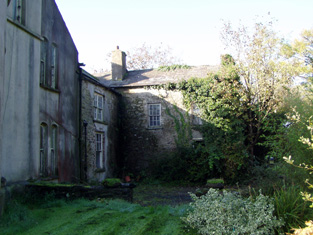
|
| Ballyvolane | Hajba writes that Ballyvolane was bought by Sir Richard Pyne of Waterpark, Lord Chief Justice of Ireland, from the Coppingers in the early 18th century. It remained in the possession of the Pyne family until the mid 20th century and is still occcupied. Valued at £44 at the time of Griffith's Valuation, the house was occupied by Jasper Pine who held it from Thomas, George and Henry Walker. By 1906 the mansion house at Ballyvolane was valued at £70+ and occupied by George M.Pyne. |

|
| Ballyrobert | Hajba writes that Michael Mackay built a house beside the ruined castle of Ballyrobert in the 1820s and he is recorded as resident there by Lewis in 1837. In the early 1850s the house was valued at £23, occupied by Michael Mackay and held from John Peard. Michael J. Mackey occupied the house in 1906. This house no longer exists. | |
| Belvidere | This house was unoccupied in 1814. Mrs Maria Peard was the occupier in the mid 19th century holding the property from Henry Peard, it was valued at £15.12 shillings. Hajba writes that the Peards sold the estate to the Pope family who occupied the house until the early 20th century. |
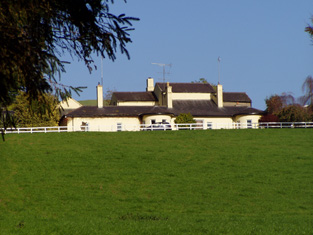
|
| Carrigeen Hall | In 1786, Wilson refers to "Carrygeen" as the seat of Mr. Peard. Hajba writes that this house was the home of Peard Harrison Peard, son of Richard Peard of Coole Abbey and father of Richard Frederick Peard of Belvidere and Henry Peard of Carrigeen. Later the home of the Green and O'Grady families, now demolished. | |
| Sun Lodge | Sun Lodge is marked on the first Ordnance Survey map and was occupied by Denis Hanan in the mid 19th century and held from Henry Peard. It was valued at £30+. Hanan's interest was advertised for sale in 1870. Hajba records various other occupants and this house is still occupied and well maintained. |

|
| Castleview | Castleview was the home of the Gumbleton family held from Henry Peard in the mid 19th century and valued at £68.15 shillings. The house remained in Gumbleton possession until the early 20th century but is now demolished. Bence Jones lists this house under the name Glynnatore and writes that it was built in 1791 by R. W. Gumbleton. In 1894 Slater notes Glenatore as the seat of Mrs. Gumbleton. | |
| Kilcor Castle | The home of the O'Brien family in the 18th and 19th centuries, sold by them in the mid 19th century. Cornelius O'Brien was the occupant in 1837 and at the time of Griffith's Valuation. He held the house valued at £17.15 shillings from James Reid. Kilcor was bought by Francis Doyne Dwyer and later passed to the Phipps family through marriage. In the 1940s the Irish Tourist Association Survey reported that it was the residence of Captain H. Phipps. |
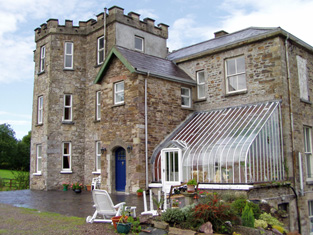
|
| Rathbarry Cottage | Rathbarry Cottage was occupied by Major William Love Peard at the time of Griffith's Valuation. The property was held from the Reverend R. Gumbleton and the buildings were valued at £11. Some ruined walls remain at the site. | |
| Towermore | The home of Mrs Maria Oliver in 1837 but leased to Frederick C. Hayes in the early 1850s. The house was valued at £45. Maria was the widow of Charles S. Oliver of Inchera and a daughter of A. Morris of Dunkettle. A. Morris Oliver is recorded as a subscriber to Lewis ''Topographical Dictionary'' published in 1837 but is not mentioned in Burkes. Earlier, in 1786, Wilson refers to Tormore as the seat of Mr. Connor. This house was not occupied at the end of the 20th century although still extant. | |
| High Park | Occupied by the Reverend J. W. Edgar in 1837 and by Bridget Hogan in the mid 19th century, valued at £12+ and held from William Coppinger. This house no longer exists. | |
| Mellefontstown | The main residence of the Nason family in the 18th century, John Nason was resident in 1814 and Pierce Cotter in the early 1850s. Cotter held the property from Thomas Wise and the buildings were valued at £19+. In May 1863 Pierce Joseph Cotter's estate at Mellifontstown, containing the house, demesne and 246 acres was advertised for sale. It was held on a lease dated 1852 from Francis Wise to Pierce Cotter for 185 years. A new house now stands on the site. | |
| Newtown Lodge | Another Nason residence, occupied by Henry Nason in the mid 19th century and held from John Nason, the buildings were valued at £21. It remained in Nason possession until the early 20th century. This house is still a family residence. |
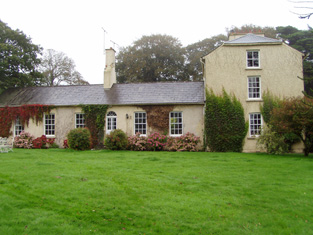
|
| Mount Prospect | A Bowles family home, occupied by George Bowles third son of Robert Bowles of Springfield and father of Spotswood Bowles of Ahern. George was resident in 1814 and his widow was living there in 1837. His son George was resident at the time of Griffith's Valuation holding the property from Minor Cormack. The buildings were valued at £28+. Later the residence of Lieutenant Colonel George Eyre Massy [son of Hugh]. |

|
| Ballymacsimon | A house located on the Devonshire estate and occupied by John Kirby in the mid 19th century. The buildings were valued at £25. William Kirby held 2 townlands in the parish of Aghera at the time of Griffith's Valuation. Home of the Collins family in the mid 20th century and still inhabited. | |
| Booladurragha South | William O'Neill was occupying a house in this townland at the time of Griffith's Valuation, the buildings were valued at £15+ and the property was held from the Duke of Devonshire. The Duke is given as the occupier of this house in 1906. A house still exists at this site. Boulta House now functions as a guest house. |
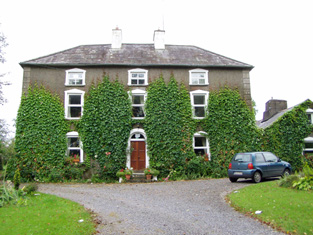
|
| Bride Park | Hajba writes that the Reverend Stephen Rolleston built this house in the 1770s. In 1814 it was inhabited by the Reverend Spread and in the mid 19th century by Thomas Power who held it from Mrs Elina Greaves and others. The buildings were valued at £20+. Bride Park remained the home of the Power family until the early 20th century. This house has recently been renovated and restored. |

|
| Carrigmore | Richard Power was resident here in 1814 and Edward Morragh in the mid 19th century. Morragh held the property from the Duke of Devonshire and the buildings were valued at £18+. Later the home of the Cronin family. Hajba writes that this house has been unoccupied since 1990. | |
| Thornhill | A Nason home, first occupied by John William Washington Nason. His widow Mrs Barbara Nason is recorded as resident at the time of Griffith's Valuation. Valued at £18.11 shillings the house was held from the Duke of Devonshire. The Nason family continued to live here until the mid 20th century. The house is still an occupied residence. | |
| Killavarilly | At the time of Griffith's Valuation John O'Neill, a doctor, held a house valued at £25+ and 350 acres from the Duke of Devonshire at Killavarilly. A house is still located at this site. | |
| Lisnabrin | A 3 storey 18th century house built by the Crokers on property inherited through marriage with the Coppingers in the 17th century. In the mid 19th century occupied by Edward Croker junior, son of Walter, the house was valued at £33+ in the early 1850s. Edward Croker died in 1901and Letitia C.C. Croker is recorded as the occupier in 1906. The property later passed to a relative Captain Walter A. Carew. The house was a hotel for a short time in the mid 20th century but is once more a family home. |

|
| Kilmacow | Located on the Devonshire estate, on the Cork/Waterford border, Kilmacow was occupied by John Boyce in 1814 and by William John Day in the early 1850s. The buildings were valued at £12. Bought by John Murphy of Tallow in the late 19th century and still extant. |
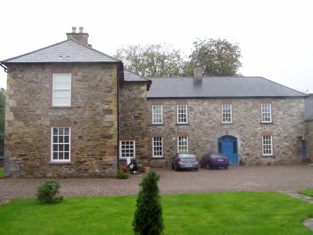
|
| Mogeely House | A house on the Devonshire estate, occupied by Charles H. Walsh in the mid 19th century and valued at £25.18 shillings. Later the home of the Des Barres and Kent families. Slater refers to it as the seat of Lt-Col. Des Barres in 1894. Still a family residence. It is labelled Mogeely Castle on the 1st edition Ordnance Survey map but as Mogeely House on the later editions, |
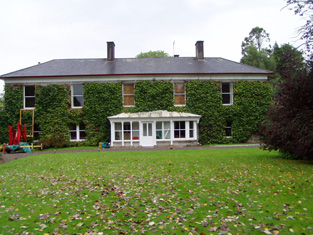
|
| Lisnabrin Lodge | Occupied by Thomas Carew in 1837 and by Sands Bellis who held the house and 28 acres from Thomas Carew in the mid 19th century. The buildings were valued at £36+. This house is extant, occupied and well maintained. |

|
| Curraglass House | Part of the Lysaght estate from the mid 18th century, W. and L. Giles are recorded at Curraglass in 1814. Earlier, in 1786, Wilson refers to it as the seat of Mr. Bonwell. By 1837 W. Gumbleton was resident and his widow Mrs Georgina Gumbleton occupied the house in the early 1850s. It was valued at £58+. Hajba writes that she was the last occupant of the house which is now demolished. | |
| Frankfort | This was a Woodley home, occupied by F. Woodley in 1837 and leased to Robert Wigmore in the early 1850s when the house was valued at £20+. The house was occupied until the 1970s but is now a ruin. |

|
| Templevally | The home of the O'Mahony family in the 19th century, occupied by William O'Mahoney at the time of Griffith's Valuation, valued at £26+ and held from Cooper Penrose. Late this house was home to the Condons. The original house is demolished and a later house is now inhabited. |
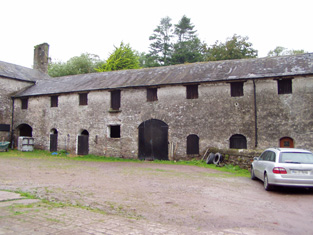
|
| Woodview | Woodview was the home of the Reverend George Nason in 1837 and in the early 1850s was occupied by his son Charles Nason who held the property from Major Edward Croker [Lisfinny]. The buildings were valued at £13+. This house is still a family residence. | |
| Clonmult | The Powers appear to be associated with Clonmult from the late 17th century. In the first half of the 19th century Pierce Power was resident, the house being valued at £23 in the early 1850s and held from Edward Phayre. A Shaw Smith home in the second half of the 19th century. Louis K. Smyth is recorded as the occupant in 1906 when the buildings were valued at £16. 15 shillings. |
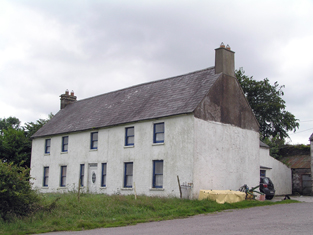
|
| Caherduggan | In 1786, Wilson refers to "Carduggan" as the seat of Mr. Davis. Denis O'Callaghan was living at Cadogan (Caherduggan) by 1837. He held the property in fee at the time of Griffith's Valuation when it was valued at £48. This house remained in the possession of the O'Callaghan family until the 20th century. It is still extant but unoccupied. |

|
| Leadinton | The home of the Atkin family for most of the 18th and 19th centuries. In 1786 Wilson refers to it as the seat of Mr. "Arkin". Valued at £16.15 shillings at the time of Griffith's Valuation, it was occupied by the Reverend Joseph Wright and held from J.T. Atkins Swanne. | |
| Breeda House | Roger G. Davis held a house in fee, valued at £17, in this townland at the time of Griffith's Valuation. Breeda House is labelled on the 25-inch Ordnance Survey map of the 1890s. A house is still extant at the site. | |
| Mount Uniacke | A home of the Uniacke family in the 18th and 19th centuries, occupied by three generations of persons named Norman Uniacke in the 19th century. Earlier, in 1786, Wilson refers to it as the seat of James Uniacke. In the mid 19th century it was held by Norman Uniacke in fee and the house was valued at £30. The Irish Tourist Association Survey of the 1940s reported that it had been burnt in 1921 and it is no longer extant. | |
| Ballyre | This house was occupied by Crofton Uniacke at the time of Griffith's Valuation when it was valued at £29.15 shillings and held from Mountifort Longfield. Earlier, in 1786, Wilson refers to it as the seat of Crofton Uniacke. The home of Robert M. Bayly in the 1870s. It is still extant. |
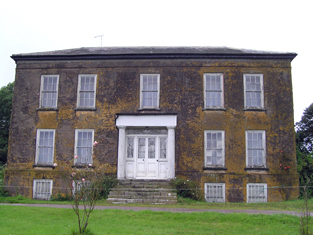
|
| Glengarra | Occupied by Robert Dring in the early 1850s, valued at £25 and held from Robert Uniacke. Still extant and occupied. |
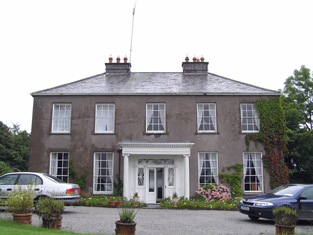
|
| Castletown | The home of James Uniache in 1814 and of Norman Uniacke in 1837. Robert Uniacke held the property in fee at the time of Griffith's Valuation when it was valued at £20. In 1786 Wilson also refers to it as the seat of James Uniacke. This house was a ruin at the beginning of the 21st century but the National Inventory of Architectural Heritage refers to its restoration. |
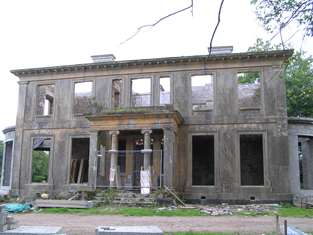
|
| Monaloo | This house was built post Griffith's Valuation. In the 1870s Charles Nason of Monaloo House, Tallow, owned 797 acres in county Cork. It is still extant. |

|
| Ballyhamlet House | James Parker was leasing Ballyhamlet from the Earl of Shannon's estate in 1851 when it was valued at £17. There is still an extant house at the site. | |
| Lisfinny House | Major Edward Croker was leasing this house from the Devonshire estate in 1851 when it was valued at £23. Lewis also recorded it as his residence in 1837 when he noted that "the ancient castle, built by the Earl of Desmond, has been converted into a handsome residence". It is still extant and occupied. |
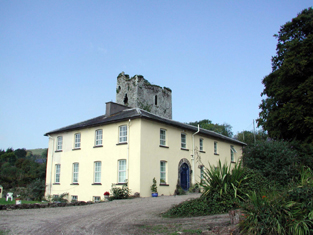
|
| Kilmore House (Tallow) | Held in fee by Rev. William Percival at the time of Griffith's Valuation, when it was valued at £37. Lewis refers to it in 1837 as "Kilmore Hill, residence of Rev. W. Percival, a handsome seat on the new line of road to Youghal". Wilson, writing in 1786, refers to the Perceval residence near Tallow as "Kilmahoe". In 1906 it was still owned by William Percival and valued at £37 10s. |
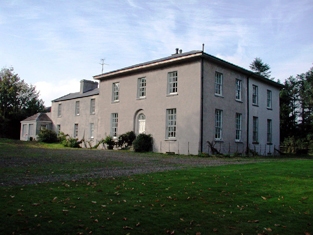
|
| Roseville (Tallow) | Leased by William Parker from the Devonshire estate at the time of Griffith's Valuation when the buildings were valued at £20 10s. It is also recorded as his address in the 1870s. Roseville is still extant and occupied. |

|
| Peafield (Templemodan) | In 1786 Wilson refers to Peafield as the seat of Archdeacon Mockler. There is no substantial house shown in this area on the 1st edition Ordnance Survey map. By the time of Griffith's Valuation, the townland was in the possession of Thomas Boyce. |

